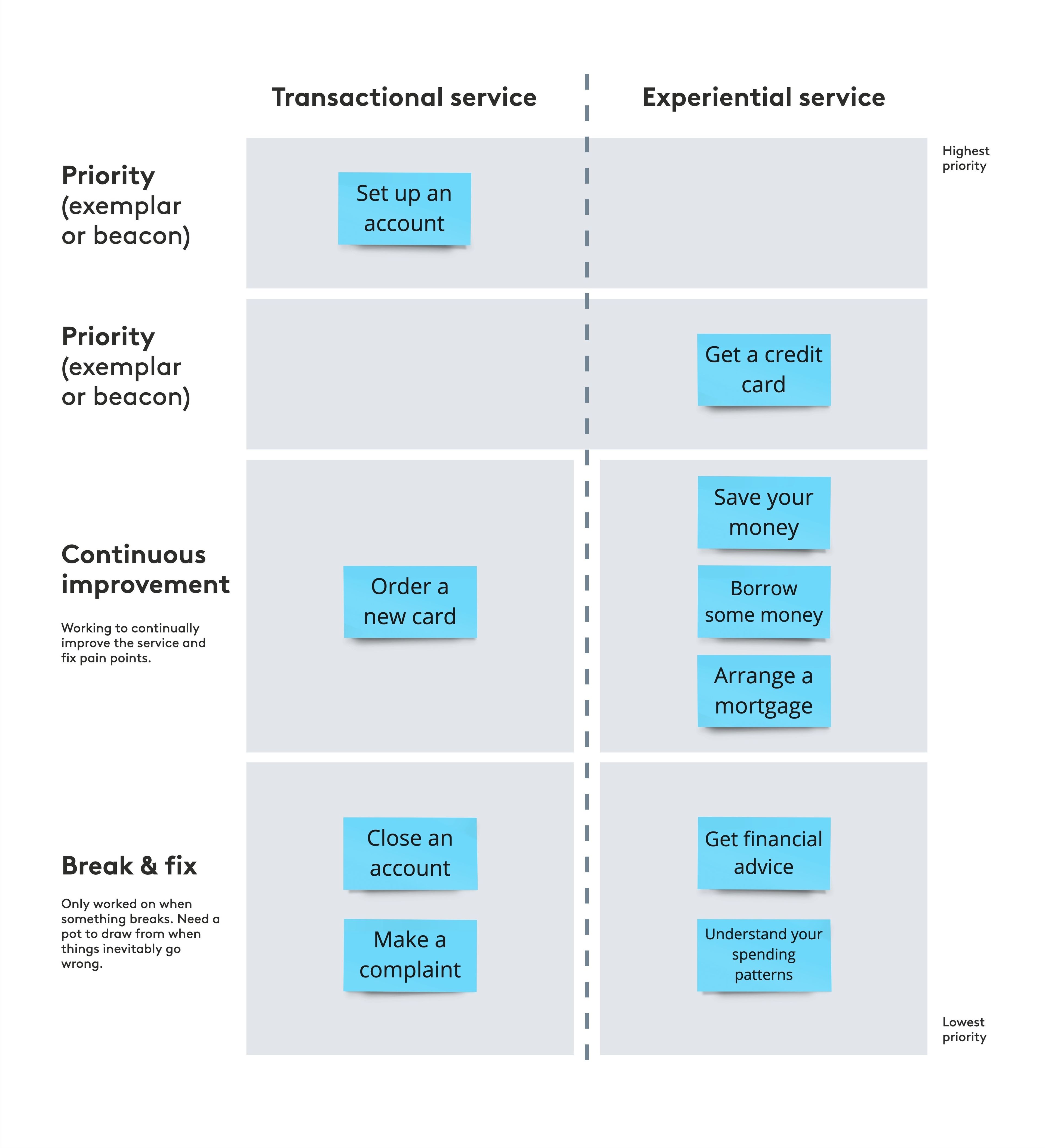
How to prioritise your services, and your effort
Prioritise your services using the Miro template.
--
The reality in all organisations is that you can’t do everything. You need to focus where you’ll see the best return on investment. That could be for operational efficiency, growth through a better customer experience, or improving the tools colleagues use.
There are always constraints and limits, and you have to make trade-offs. The utopia of good services is long-lived teams, and that means making some tough decisions about which services to invest effort in.
This is never an easy decision.
But, it can be a well considered and informed decision.
Framing the services
Assuming you’re clear on what your services are, the first step is to plot your services according to their shape.
Consider for each service:
Is it a transactional service? These are all about operational efficiency to get a job done with minimal effort for the user. These services should be streamlined to the simplest user experience. It requires sufficient scale to achieve optimal efficiency with these.
Is it an experiential service? This is all about the mission of your organisation - not just its smooth running, but seeking radically better experiences. The focus is user experience - are users able to achieve the outcomes they’re seeking? This is about adding value at scale.
Are interaction volumes low? If so, it's probably a one-off task for a few people, and not worth devoting substantial energy to in comparison to higher volume services.
Are interaction volumes high? High interaction volumes either mean a high number of users, a high frequency of usage, or both. This suggests it’s important enough for you to invest some effort in.

Map your services on the matrix, considering their objectives and user impact. It's about finding the sweet spot between transactions and experiences. It’s unlikely you’ll prioritise a service with low interaction volumes, so typically you’ll be looking in the upper half.
Focusing on highly transactional services in the upper far left can help you to cut costs, but you’ll quickly run out of savings to make. If there are big inefficiencies in these services (for example, a problem in the service is driving dissatisfaction and a disproportionate number of calls to the contact centre), you might choose to prioritise effort here in the short-term.
Highly experiential services in the upper far right offer growth opportunities through a better user experience, but the user needs at this end of the spectrum are so complex to serve at scale that they usually outweigh potential growth return.
The services that fall in the upper middle of the matrix are typically where you should focus your effort. These services have a mix of cost-saving and growth opportunities.
Deciding your priorities
Prioritisation demands tough choices. It's about acknowledging which services require the most attention and which will create the most impact for your effort. This clarity prevents spreading your investment too thinly.
Use this to help think about the services you focus on and plan where you invest time, people and effort. Consider which services you can create the most impact.
Using the services from the upper middle of the matrix, organise them in a simple priority order of potential impact. Don’t make this any more complicated than it needs to be. The easiest way to do this is using a criteria that helps you to decide:
Which services are most important to your organisation and your users?
Which services are causing the most problems for your organisation and your users, and need the most improvement?
(There’s an example of a more detailed criteria in the Miro board template.)
Do this as a draft with the people who are accountable for services in your organisation, keeping the group as small as possible. Gradually bring more people in to get their feedback, and bring them onboard. Aim to do this quickly and only ask people for their input on the services they understand and have a hand in. Too much deliberation will not help you.

Remember, these priorities aren’t forever, it’s about being clear about what’s most important now. Choose no more than 3 services as priorities. Have as many services as you can realistically afford in continuous improvement. Any services that are left will have to go into break and fix mode.
This prioritisation should force you to make some tough decisions. It should push you to consider which services you're investing in and which you are consciously neglecting in break and fix. It's better to know this than to pretend it's not happening.
Making priorities real
Once you've prioritised, look at whether funding, governance and teams are in place for each service according to position. Consider that despite the teams' best efforts on some of the services, without changes to your operating model, modes such as continuous improvement may not be possible.
If your organisation follows an annual planning cycle, it’s sensible to fall in line with that cadence and revisit the priorities each year. You may need to go through this exercise a few times with decision makers and leadership to get people on the same page. Then you’ll need to share your decisions across teams, and make any necessary changes to funding and team shapes. Regularly communicate and repeat the priorities, at the start of team meetings, workshops and even emails.
Prioritisation decisions are hard. They require trade-offs and compromise. Not everyone will be happy with them, but if everyone can understand the reasons why some services are prioritised over others they will be more able to accept them. It’s best to do this consciously, and in the open. That way everyone knows where they stand, and is clear on your organisational focus.
Here’s a Miro template so you can try this out in your organisation. This method was developed by Katherine Wastell and Audree Fletcher.
Written by

Katherine Wastell
Senior Director

